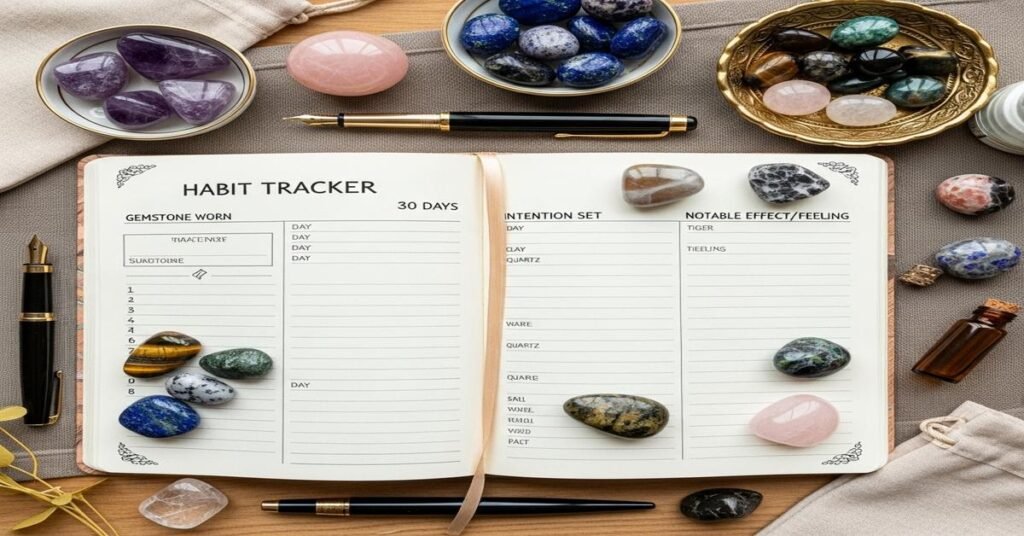Wearing a gemstone daily tells you a lot about the piece. A 30-day habit tracker turns impressions into data. You learn how a stone wears, whether settings loosen, how skin and products affect metal, and how comfortable a piece really is. That matters for maintenance, resale value, and comfort. Below are practical things to log, why each item matters, and a simple template you can use on paper or in a notes app.
What to measure and why
- Time worn (hours): Record when you put the piece on and when you take it off. Why: continuous wear exposes metal and gems to sweat, soaps, and knocks. If a ring shows problems after long shifts, the solution is different than if it fails during short wear.
- Activity level / tasks: Note whether you cooked, gardened, typed, lifted weights, slept, or showered while wearing. Why: mechanical stress and abrasives cause prong wear and scratches. Example: gardening increases the chance of prong snags; dishwashing adds detergents that dull polish.
- Stone type, size, and measurements: Record gem type, carat (ct), and diameter in millimeters (mm). Why: durability and care differ by material. Example: a 1.0 ct round diamond (~6.5 mm) resists scratches; a 1.0 ct opal needs humidity care. Write “Diamond, 1.00 ct, 6.5 mm.”
- Metal/alloy and thickness: Note alloy (14k yellow gold, 18k white gold, platinum, sterling silver) and band thickness in mm. Why: softer alloys (18k) wear faster than harder ones (14k) because they have more pure gold. Example: 14k gold ≈ 58.3% gold, 18k ≈ 75% gold; higher gold content = softer metal.
- Visible dirt / film: Rate on a scale (0 none–3 heavy) and describe (skinned grease, sunscreen, soap film). Why: dirt hides chips/cracks and reduces brilliance, especially on diamonds that attract oil.
- Stone mobility / setting integrity: Check for wiggle or prong gaps. Use a gentle “shake test” by tapping carefully or observing under a loupe. Why: early prong movement predicts lost stones. Note “prong 3 slight lift” or “no movement.”
- Surface damage: Note scratches, chips, or dings and which surface. Why: small abrasions develop before bigger failures. Example: a chip on emerald edge often suggests previous impact or internal fissures.
- Skin reaction: Note redness, irritation, or discoloration. Why: indicates metal reaction to sweat, lotions, or plating wearing off (rhodium on white gold). Example: green staining usually means copper alloy exposure or reaction to acidic sweat.
- Cleaning and method: Log when you clean and how — warm water and dish soap, ultrasonic, steam, or jeweler’s cloth. Why: some gems (pearls, opals, emeralds) don’t tolerate ultrasonic cleaners; others (diamonds, sapphires) do. Example: “Day 7: warm soap, soft brush — no loose stones, better sparkle.”
- Environmental exposure: Note chemicals (perfume, hand sanitizer, chlorine) and extremes (heat, cold). Why: acids and chlorinated pools can de-plate or damage porous stones and treatments. Example: “Pool on day 12 — rhodium plating dull; remove next swim.”
- Photos: Take a daily photo in consistent light and background. Use a ruler or mm card for scale. Why: visual records catch progressive changes you miss day-to-day. Store with date and note.
- Comfort and fit: Rate comfort (1–5) and record rotation or slipping. Why: swelling or sizing changes reveal when to re-size. Example: ring tightness in afternoon suggests temperature or weight change; you might need a half-size change.
- Comments / reactions: Record compliments, how it pairs with outfits, or emotional response. Why: wearability is also aesthetic. If two pieces get daily compliments, that indicates frequent use value.
Stone-specific cautions — what to pay attention to
- Pearls: Track exposure to perfumes, cosmetics, and dryness. Pearls are organic and can lose luster quickly with chemicals.
- Opals: Log humidity and sudden temperature shifts. Opals can craze or crack when they dry out.
- Emeralds: Note any oily or glassy look — many emeralds are oiled. Oil loss changes appearance and indicates a need for re-treatment.
- Diamonds: Watch for greasy film and chips at the girdle. Diamonds scratch other gems and collect oil, which dulls brilliance.
- Sapphires and rubies (corundum): Very hard but can fracture on blunt impact; log knocks or pressure events.
Tools to make logging reliable
- Smartphone with macro lens or consistent photo setup.
- 10x jeweler’s loupe for prong/stone checks.
- Digital calipers (mm) and small digital scale (grams) to confirm measurements.
- Soft cloth, small zip pouch for storage, and nitrile gloves if handling oils.
Daily template you can copy
- Date:
- Piece (type, ct, mm; metal):
- Time worn (on/off):
- Activities (brief):
- Cleaning done (method):
- Visible dirt (0–3):
- Prong/stone movement (yes/no; details):
- Surface damage (describe):
- Skin reaction (describe):
- Photo saved? (Y/N):
- Comfort (1–5):
- Notes / compliments:
How to review after 30 days
- Look for repeated issues: If prongs loosen on certain fingers or during specific activities, remove the piece for those tasks or ask a jeweler to reinforce settings.
- Compare photos to catch small chips or patina changes you missed in real time.
- Translate findings into action: more frequent cleaning, rhodium re-plating, re-sizing, or switching to a harder alloy (e.g., platinum instead of 18k gold) if wear is excessive.
- Update insurance and appraisals if you notice substantial wear or if a stone has changed appearance.
Tracking for 30 days gives you objective evidence, not just a feeling. You’ll know whether a piece is truly wearable daily, needs altered care, or should be retired for heavy activities. The data also improves conversations with your jeweler because you’ll supply exact dates, photos, and a pattern — and that makes diagnosis and repair faster and more accurate.
I am G S Sachin, a gemologist with a Diploma in Polished Diamond Grading from KGK Academy, Jaipur. I love writing about jewelry, gems, and diamonds, and I share simple, honest reviews and easy buying tips on JewellersReviews.com to help you choose pieces you’ll love with confidence.

